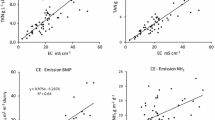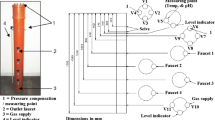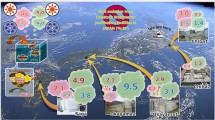Abstract
Pig farms have achieved importance in the last few decades from the perspective of environment protection as a consequence of the intensive rearing systems in livestock production. Ammonia (NH3) and greenhouse gases (GHG), such as methane (CH4), carbon dioxide (CO2), and nitrous oxide (N2O), are emitted from slurry storage at farm prior to land application, but little is known about these losses under on-farm conditions in Spain. This study assessed the influence of management and environmental parameters on NH3 and GHG emissions from slurry storage in spring and autumn. Gas emissions were measured in a commercial pig-fattening farm from two lagoons (1000 and 768 m3 capacity, respectively) during 30 days by the floating dynamic chamber system in spring and autumn 2011 (average temperature 19 and 9 °C, respectively). Low NH3 and CH4 emissions were registered in spring (range 10–406 and 3–17 mg m−2 min−1, respectively) probably as a result of low pH values of stored slurry (6.5 to 7.0) and rainfall. High variability on NH3, CH4, and CO2 emissions was observed as a result of differences in temperature and rainfall. No NH3 emission and low CH4 and CO2 emissions were observed in autumn (average 1.2 ± 0.9 and 27 ± 22 mg m−2 min−1, respectively). Slurry loading operations increased NH3 losses from storage.


Similar content being viewed by others
References
AFNOR, Association Française de Normalisation (1976). Standard U44-160. Saint-Denis, France.
Anderson, N., Strader, R., & Davidson, C. (2003). Airborne reduced nitrogen: ammonia emissions from agriculture and other sources. Environment International, 29, 277–286.
Aneja, V. P., Bunton, B., Walker, J. T., & Malik, B. P. (2001). Measurement and analysis of atmospheric ammonia emissions from anaerobic lagoons. Atmospheric Environment, 35, 1949–1958.
Anthonisen, A. C., Loehr, R. C., Prakasam, T. B. S., & Srinath, E. G. (1976). Inhibition of nitrification by ammonia and nitrous-acid. Journal of Water Pollution Control Federation, 48, 835–852.
Attal, A., Ehlinger, F., Audic, J. M., & Faup, G. M. (1988). pH inhibition mechanisms of acetogenic, acetoclastic and hydrogenophilic populations. In E. R. Hall & P. N. Hobson (Eds.), Anaerobic digestion 1988: proceedings of the fifth international symposium on anaerobic digestion (pp. 71–78). Bologna: Pergammon Press.
Blunden, J., & Aneja, V. P. (2008). Characterizing ammonia and hydrogen sulfide emissions from a swine waste treatment lagoon in North Carolina. Atmospheric Environment, 42, 3277–3290.
Braun, R., Huber, P., & Meyrath, J. (1981). Ammonia toxicity in liquid piggery manure digestion. Biotechnology Letters, 3, 159–164.
Chadwick, D., Sommer, S. G., Thorman, R., Fangueiro, D., Cardenas, L., Amon, B., & Misselbrook, T. (2011). Manure management: implications for greenhouse gas emissions. Animal Feed Science and Technology, 166–67, 514–531.
Dai, X. R., & Blanes-Vidal, V. (2013). Emissions of ammonia, carbon dioxide, and hydrogen sulfide from swine wastewater during and after acidification treatment: effect of pH, mixing and aeration. Journal of Environmental Management, 115, 147–154.
Dinuccio, E., Berg, W., & Balsari, P. (2008). Gaseous emissions from the storage of untreated slurries and the fractions obtained after mechanical separation. Atmospheric Environment, 42, 2448–2459.
Flesch, T. K., Verge, X. P. C., Desjardins, R. L., & Worth, D. (2013). Methane emissions from a swine manure tank in western Canada. Canadian Journal of Animal Science, 93, 159–169.
Gerber, P.J., Steinfeld, H., Henderson, B., Mottet, A., Opio, C., Dijkman, J. et al. (2013). Tackling climate change through livestock. Technical report, FAO, Rome, Italy.
Harper, L. A., Sharpe, R. R., & Parkin, T. B. (2000). Gaseous nitrogen emissions from anaerobic swine lagoons: ammonia, nitrous oxide, and dinitrogen gas. Journal of Environmental Quality, 29(4), 1356–1365.
Hartung, J., & Phillips, V. R. (1994). Control of gaseous emissions from livestock buildings and manure stores. Journal of Agricultural Engineering Research, 57, 173–189.
Intergovernmental Panel on Climate Change (2006). IPCC Guidelines for national greenhouse gas inventories, vol.4. Agriculture, forestry and other land use. In H.S. Eggleston, L. Buendia, L. Miwa, T. Ngara, K. Tanabe (Eds.), Prepared by the National Greenhouse Gas Inventories Programme IGES, Hayama, Japan.
James, K. M., Blunden, J., Rumsey, I. C., & Aneja, V. P. (2012). Characterizing ammonia emissions from a commercial mechanically ventilated swine finishing facility and an anaerobic waste lagoon in North Carolina. Atmopheric Pollution Research, 3, 279–288.
Kaharabata, S. K., Schuepp, P. H., & Desjardins, R. L. (1998). Methane emissions from aboveground open manure slurry tanks. Global Biogeochemical Cycles, 12, 545–554.
Lim, T. T., Heber, A. J., Ni, J. Q., Sutton, A. L., & Shao, P. (2003). Odor and gas release from anaerobic treatment lagoons for swine manure. Journal of Environmental Quality, 32, 406–416.
Moller, H. B., Sommer, S. G., & Ahring, B. K. (2004). Biological degradation and greenhouse gas emissions during pre-storage of liquid animal manure. Journal of Environmental Quality, 33, 27–36.
Nielsen, H. B., & Angelidaki, I. (2008). Strategies for optimizing recovery of the biogas process following ammonia inhibition. Bioresource Technology, 99, 7995–8001.
Park, K. H., Thompson, A. G., Marinier, M., Clark, K., & Wagner-Riddle, C. (2006). Greenhouse gas emissions from stored liquid swine manure in a cold climate. Atmospheric Environment, 40, 618–627.
Peu, P., Beline, F., & Martinez, J. (1999). A floating chamber for estimating nitrous oxide emissions from farm scale treatment units for livestock wastes. Journal of Agricultural Engineering Research, 73, 101–104.
Phillippe, F. X., & Nicks, B. (2015). Review on greenhouse gas emissions from pig houses: production of carbon dioxide, methane and nitrous oxide by animals and manure. Agriculture, Ecosystems and Environment, 199, 10–25.
Rodhe, L. K. K., Abubaker, J., Ascue, J., Pell, M., & Nordberg, A. (2012). Greenhouse gas emissions from pig slurry during storage and after field application in northern European conditions. Biosystems Engineering, 113, 379–394.
Sharpe, R. R., Harper, L. A., & Byers, F. M. (2002). Methane emissions from swine lagoons in southeastern US. Agriculture, Ecosystems and Environment, 90, 17–24.
Spanish Ministry of Agriculture (1974). Official methodologies for soil and water analysis. Madrid, Spain.
Szögi, A. A., Vanotti, M. B., & Stansbery, A. E. (2006). Reduction of ammonia emissions from treated anaerobic swine lagoons. Transactions of the ASABE, 49, 217–225.
United Nations (2013) Demographic components of future population growth. Technical Paper No. 2013/3. 19pp.
Vallejo, A., García-Torres, L., Diez, J. A., Arce, A., & López-Fernández, S. (2005). Comparison of N losses (NO3 -, N2O, NO) from surface applied, injected or amended (DCD) pig slurry o fan irrigated soil in a Mediterranean climate. Plant and Soil, 272, 313–325.
VanderZaag, A. C., Flesch, T. K., Desjardins, R. L., Baldé, H., & Wright, T. (2014). Measuring methane emissions from two dairy farms: seasonal and manure-management effects. Agricultural and Forest Meteorology, 194, 259–267.
Acknowledgments
This work has been funded by BATFARM Interreg-Atlantic Area Project (2009-1/071) entitled “Evaluation of best available techniques to decrease air and water pollution in animal farms”. Maialen Viguria holds a grant from the Ph.D. student’s research program of the Department of Education, Universities and Research of the Basque Government. The authors are especially grateful to the farmer that provided agricultural infrastructure and to the University of the Basque Country for the computer facilities.
Author information
Authors and Affiliations
Corresponding author
Rights and permissions
About this article
Cite this article
Viguria, M., López, D.M., Arriaga, H. et al. Ammonia and Greenhouse Gases Emission from On-Farm Stored Pig Slurry. Water Air Soil Pollut 226, 285 (2015). https://doi.org/10.1007/s11270-015-2548-6
Received:
Accepted:
Published:
DOI: https://doi.org/10.1007/s11270-015-2548-6




